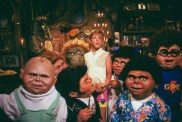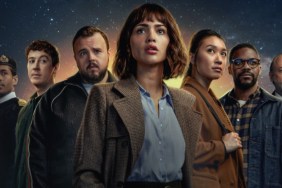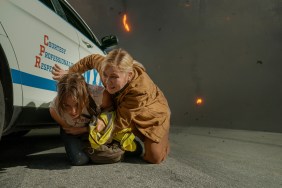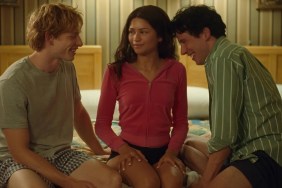On Fantastic Flesh and the future

Greg Nicotero puts on his executive producing hat for an original Starz documentary airing this month entitled Fantastic Flesh: The Art of Make-Up EFX (check your local listings for show times). Directed by Kevin VanHook, the doc is alternately a look inside the walls of KNB EFX’s shop and at the industry’s legends, past and present.
It had been some time since I visited KNB (five years, in fact), so I jumped at the opportunity to swing by and talk with Nicotero. Still located in the San Fernando Valley, the shop had not changed all that much. The only palpable difference was the absence of KNB’s massive show room which once hosted an assortment of creatures, from the old tentacled, axe-wielding hag seen in In the Mouth of Madness to the beast featured at the end of The Faculty. The space is now reserved for Nicotero’s office which is a museum in and of itself. Here you’ll find model kits, a shrine to Jaws, Dawn of the Dead action figures and books on top of DVDs on top of books.
During our candid conversation – which spans Fantastic Flesh and KNB’s upcoming projects such as Piranha and Jennifer’s Body – a very “Hollywood moment” occurred as a makeup FX maestro dropped in for a brief visit.
ShockTillYouDrop.com: What was the impetus behind producing Fantastic Flesh?
Greg Nicotero: Initially, we always thought we have all this great behind-the-scenes footage and all this stuff that weâve shot on all these sets. And 1988 was the year that we started KNB, so we kind of thought, “Oh, it would be cool to do a mini retrospective on KNB, but also acknowledge everybody else.” It became a lot bigger than that because if I’m going to watch a show like this, I want to see cool clips from The Thing and stuff from Dawn of the Dead and hear from all the people that I grew up being fans of and being inspired by. From Starz, of course, they wanted to make sure that there were a lot of famous faces in it. And this was truthfully one of the first times that I ever started calling in favors. So we called in Quentin [Tarantino] and Simon Pegg, Josh Brolin, Robert Rodriguez, Tom Savini and George Romero, and Eli [Roth]. We had a really short time frame to shoot the documentary and to shoot the pieces. We had gone out to Rick Baker, and Stan Winston, and Dick Smith, and we really wanted it to be sort of an overview with just a sprinkling of our work along in there with all the other stuff. Rick was in the middle of making The Wolfman and over in London. He’s well represented in the documentary, we just really didn’t get a chance to get him on camera. With Stan, he was the first guy that I worked for when I went out to L.A., we would’ve loved to have had him as part of the documentary. At that point he was really ill and it wasn’t even known how sick he really was at the time. We had reached out to him and said, “Hey, you know what would be great? We’re doing this documentary and we’d love to see you represented and talk about your contributions to special effects makeup, and animatronics, and creatures and stuff.” We got a, “Oh, unfortunately he’s not available to do any interviews right now.” So I mean, we had no idea, we would’ve never even bothered him. Or we would’ve just gone to somebody else at his studio if we would’ve known. But at that time it was still sort of quiet. I was really excited that of course we were able to get Tom Savini, and Dick Smithâ¦
Shock: And Rob Bottin…
Nicotero: And Rob Bottin! He came through us through my friend Jovanka who is the editor of Rue Morgue Magazine. I thought that would be great to get a chance to actually hear from Rob directly. He’s such an amazingly talented guy. Truthfully, when we originally when we pitched it, it went through several incarnations. I kind of started off saying, “You know, you’ve got to talk about Ray Harryhausen, you’ve got to talk about Famous Monsters Magazine. You’ve got to talk about Jack Pierce…”

Shock: There’s enough history to cover a documentary much longer than Flesh.
Nicotero: Well, it ends up becoming: How do you handle this? Do you focus on the technical aspect of it, or what? So it really had a lot of different directions that it could go in. I would’ve loved to have seen a little section about what inspired all these guys to do special effects, a little bit on Famous Monsters and on all the films. I remember talking about playing Creature from the Black Lagoon and there were the eight minute condensed versions, and you would play it in forward and you would play it in reverse. There was no video, you had to scour the TV Guide just to find a viewing of any monster movie you wanted. The first step was going in the back of Famous Monsters and buying the condensed versions which I still have. When I originally thought about the documentary, I thought, “How cool would it be to get people’s impressions when they were younger? What fueled guys like John Landis and Joe Dante into becoming directors? And guys like Dick Smith, Rob Bottin and Tom Savini into being special effects makeup guys?” It could’ve been longer and we could’ve covered a lot more stuff, but I think that getting Dick in there and seeing the face of the guy who created The Exorcist and Taxi Driver… To me I still watch [his FX] and go, “God, how great is that?” Modern day audiences, with the advent of special features on DVDs, know who The Exorcist is, and they know who is involved in it, but to be able to see [Smith] talking about it, and to be able to see Rob Bottin talking about The Thing. That’s what excited me about it. Those are the high points for me.
Shock: What I find attractive about the piece is it lends a certain nostalgia for the fans, like myself, who had grown up on the horror clip and FX specials like Tom Savini’s Scream Greats or Terror in the Aisles. There’s also a certain level of anonymity with today’s CG FX, this doc puts a face to the makeup FX. Do you think audiences have lost a sense that these godfathers of the biz are still out there?
Nicotero: Well, I don’t think that people have forgotten who the pioneers are, but I think that it certainly isn’t as prevalent as it was fifteen years ago. I was talking yesterday – doing an interview for the Friday the 13th documentary – and the first thing they came out and they said, “Well, how do you feel about the gore aspect of it?” And I said, “Those films became famous in a large part because of Tom Savini.” Friday the 13th came out right after Dawn of the Dead. People, me included, went to the theaters to see Friday the 13th because I knew the guy that had done Dawn of the Dead had done the effects on that movie and I wanted to see what other magic trick he had up his sleeve. Now the magic tricks are done with a variety of techniques and it’s all over the place, but back then you went to see the werewolf transformation. That was the reason why you went to the movies.
Shock: Do you think today’s generation of horror fans do the same thing? Go into a film to see what their favorite FX masters have pulled off?
Nicotero: I think so, but I think it became a unique shift where the movies became more about the gag than about the movie. I know John Carpenter always talks about the criticism that The Thing took because there were so many effects on it, but again, that to me that’s one of the greatest films made in Hollywood in recent years and still holds up. You can put that movie on today and it’s still great and a lot of it is thanks to Rob Bottin. It’s a great cast, great director. But the days of sort of stopping the movie for a transformation, now it’s just like, you just want to see it in one shot. There’s never going to be a three minute transformation anymore. There’s no way an audience would sit through it even though it would look cool and they’d be like, “Oh man, look, his hand stretches, and his snout grows, and the teeth grow.” It’s just a different audience now.
Shock: I just realized we’re sitting in what was formerly the KNB showroom.
Nicotero: When we did the Narnia films we realized that real estate was at a premium at the shop, so we kind of gave up the display room. It’s funny, if you really think about it, Stan Winston, was the first guy that it was all about presentation. You go to his shop – even when I first started working here – and he had his little display room and there’d be the Terminator, and they were working on Aliens at the time. In subsequent years when you’d go to Stan’s shop, there was a T-Rex, an Alien, a Predator and Pumpkinhead – all of this really cool stuff. So it was really about, “Here’s our display room, and here’s some samples of work that we’ve done.” And in our studio here, we had 100 people working, we didn’t really have a lot of places for display stuff. We figured, “Okay, our work speaks for itself. Here’s a DVD and here’s samples of the stuff that we did.” I would still love to have all kinds of creatures and monsters lying all around the shop. We still do have some stuff, but we don’t have a room dedicated to it anymore because we had to spread out to allow for wig makers, sculptors, mold makers, and all this kind of stuff.
Shock: Which is pretty indicative of the massive growth the company has had in the 20 years it’s been around. Does KNB still make itself available to the young, indie filmmakers?
[At this point Tom Savini walks into the room, eyes scanning Nicotero’s office like a kid in a candy store. He’s in town to shoot segments for the Friday the 13th documentary His Name Was Jason (photo gallery). The interview breaks for a bit so Savini and Nicotero can catch up.]

Shock: Before that awesome tangent we were talking about KNB and its availability to indie filmmakers. Has KNB grown too big for them to afford?
Nicotero: We still have a great reputation with most of the clients that we work with. And the trick is is that, a lot of times I’ll come and go, “Hey listen, we’re going to do this big huge movie.” Like Michael Bay and The Texas Chainsaw Massacre is a perfect example because we’ll do Bad Boys II and we’ll do Transformers and all this stuff. Then he has this other company that does the horror stuff, they call us. And we just did The Unborn with David Goyer. And then again, this year ironically alone we did Jennifer’s Body, those aren’t big films, but you get the opportunity to work with somebody like Diablo Cody. Sam Raimi went back to his horror routes and did Drag Me to Hell. But it’s difficult because then you’ll get a call from somebody like Wes Craven saying, “Hey, we’re remaking Last House On the Left and we want you guys involved in some capacity.” We do a lot of big movies with these guys, and then when they have their smaller movies, it’s their brand, and they want us to be a part of their brand. I’ve been dealing with George Romero and his zombie film for the last several weeks just consulting with the makeup effects crew up in Toronto. How do you say no to guys that have helped you get where you are? And with Eli, Quentin and Robert Rodriguez, it’s the same deal.
Shock: Well, when I talk low budget, that’s what I was thinking: Eli when he did Cabin Fever, not Hostel…
Nicotero: That was basically a favor for David Lynch. But again, we get calls for all kinds of projects and some people are like, “Yeah, this is probably too big, or too little, or too this.” If we’re not really busy and we have time to do it…listen, lower budget, smaller films, it forces you to be creative. You don’t have what Rob Tapert always named the “money hose” back when we were doing Army of Darkness. “Oh yeah, back when we did Dark Man, you know, any problem we had they would just turn on the money hose and the problem would go away.” Which I think is a great, great analogy for Hollywood.
Shock: That’s a great way of putting it.
Nicotero: Any trouble you get into you turn the hose on and if you throw enough money on it, the problem goes away. The challenge with lower budget filmmaking is that the money hose doesn’t exist. So you have to be creative and come up with cool ways to do stuff and that’s really all what makeup effects stuff is always all about is coming up with new ways of things we haven’t seen before. George said something really interesting. We were talking about Dawn of the Dead and zombie bites and stuff the other day he just said, “You know that zombie bite in Dawn of the Dead was just always the one that had the most impact of any movie.” And I’m like, “Yeah, because nobody had seen it up to that point.” Now when you watch a zombie movie, you wait for the obligatory zombie bite, or the guy to get his guts ripped out or torn in half. But what our goal is is to come up with stuff that will resonate with people like those things did. And it’s half makeup effect, half choreography. You really got to set it up so that you pull the audience in so that when something happens, it’s not only a shock, but it imprints something in their brain. And that’s harder and harder to do.
Shock: It seems there’s a select group of filmmakers today who understand the delicate balance between practical and CG FX. There’s an even smaller group relying solely on practical. I’m curious to hear your take on this since there always seems to be this public outcry about an over-reliance on CG.
Nicotero: Frank Darabont and Guillermo del Toro are perfect examples [of using that balance]. Even Quentin you know, is not a big CGI effects guy. Quentin a practical guy all along which is funny because you have Robert who has similar sensibilities, but he likes the palate of visual effects. Sin City is a great example of creating this entire otherworldly look. If you know how to use your tools, there’s a perfect combination of practical stuff and digital stuff, and the marriage, when it works, it works really well. Guillermo knows how to do it better than anybody because he doesn’t shy away from shooting a guy in a rubber suit. Whereas, a lot of other people, sometimes you get them on set and they go, “Ah, it’s just going to look like a guy in a rubber suit.” Well yeah, if you shoot it standing like this looking really stiff. So you get great suit performers in there like Doug Jones or Derek Mears – guys that bring the suit to life. That’s when it really, really works. You get really excited about it when you have a great designer, you have a great performer. It looks cool on set, your director wants to shoot it, and it’s well lit by the DP…all the things that guys like Tom Savini, Rick Baker, Stan Winston and Rob Bottin fought for in the eighties. Now it just gets like, “Oh, we’ll just fix it in post, or we don’t have time to finesse it.” But when they take the time to finesse it and the time to make it look right, boy oh boy, it looks f**king amazing.

Shock: Is KNB the well-oiled machine that you had always envisioned it being 20 years ago? Do you think there’s more room for expansion?
Nicotero: We’re always pushing the envelope in terms of coming up with things that we think are cool like The Unborn or Drag Me to Hell. Drag Me to Hell was probably one of the most fun film experiences I’ve had in the past five years,. We had done twelve or fourteen projects with Sam Raimi and when Spider-Man and Spider-Man 2 came up, we didn’t work on those projects. On Spider-Man 3 they had called and said, “Listen, we have a few puppets and we want to sort of get you back into Sam’s fold again.” So when we did Drag Me to Hell it was a really great creative process, Sam’s such an imaginative guy that I still feel like I’m learning when I work with him because you’ll read and see it on the printed page, and then you get on set and you talk about it, and Sam starts adding his fingerprints to it and his flourishes â and of course it makes complete sense. You’re getting a little view of how his mind thinks. And I’ll tell you, there’s not a lot of people like Sam Raimi. And it was so much fun and he was so enthusiastic and appreciative. Again, going back with the Guillermo del Toro scenario, he loves utilizing every trick in his bag and he doesn’t shy away from it. So it was just a great, great experience and we really had fun.
Shock: How about Jennifer’s Body. Was director Karyn Kusama a practical FX fan?
Nicotero: The requirements for that show were very different because the gag of that show was [Megan Fox] gets possessed by this demon and it manifests itself seriously. We designed the look, but ultimately it was the combination of a prosthetic and a visual effect to accomplish it. I wasn’t arguing or fighting with the visual effects people about it, we really worked together to determine how best to pull of this visual thing. And it was really, really well which was kind of fun knowing that we worked with Karyn to design the look, and then I interfaced with Erik Nordby at Deluxe in Vancouver. We came up with a bunch of different ways to accomplish it with various prosthetics. Some that were painted green, and some that allowed for things to happen. And Mike Fields, who was the on-set supervisor, we basically gave them five different versions and said, “Okay, shoot these five tests, take them, and comp in what you want in the computer. Let’s see which one gives us the most striking visual.” Karyn’s certainly not a horror movie person and she’s not a person that would be able to refer to a lot of monster films, or genre movies like Darabont, Sam, or Guillermo.
Shock: Aside from the repeat business, is KNB being more selective, or are you looking for anything particular when a script comes your way?
Nicotero: We’re still being pretty selective. Jennifer’s Body is a perfect example because I met Diablo and we were sort of fans of each other. She knew my work, I knew her work, and she was like, “Hey, I’m doing this horror movie. You’ve got to check it out.” And when I read it I just laughed out loud and it was really funny. I was really was excited about working on that project. It wasn’t a super big budget for us or anything, and we didn’t have a heck of a lot of stuff to do, but it was just enough. Same thing, like with Mirrors, working with Alexandre Aja. Do we get scripts that we’re not interested in doing? Yeah. Do we turn them down? Yeah, I mean just as anybody does. But again, the volume of work that we do has a lot to do with the repeat business that we get when people call. Right now, Howard’s in Boston on a film called Edge of Darkness that Martin Campbell’s directing because we had done stuff on Casino Royale. I’m getting ready to go to Berlin on Tarantino’s movie, and we’re doing a TNT movie about a doctor named Ben Carson who was the first doctor to successfully separate conjoined twins. We’re doing surgery prosthetic stuff.
Shock: You’ve also got Piranha on the way, which I understand has been pushed back.
Nicotero: The thing is, everybody wants to make the movie and it’s going to be a complicated film. They want to shoot it in 3-D and it’s going to have a lot of effects stuff. The closer we get to winter, the temperature of the water is changing. You can’t really shoot nights in November exterior because you would freeze your actors. It really became a factor of everyone’s committed to making the movie. They’re really excited about it, but they didn’t want to rush it into production. They wanted to take the time to prep the movie adequately, shoot it in the spring so we’re not fighting weather issues. Which I think is a really smart move because originally we would’ve had seven weeks to prep it and we would’ve had to start with the big finale and the whole ending of the movie the first week of shooting. We’re still designing stuff, and we’re still in the preliminary stages. Alex is storyboarding everything and moving forward.

Shock: The trailer for The Unborn at Comic-Con did a deft job of showcasing KNB’s work.
Nicotero: Well The Unborn was a great example because David and I got along really, really well. He’s got a really good mind for disturbing visuals. And we came up with one character that was just something that he and I were sitting in his office talking about. We were talking about stuff that kind of creeped us out and I said, “My old roommate had like a dead horseshoe crab in his room.” And I said, “Every time he would pick it up and show the little claws underneath it would always freak me out. Kind of like a hairy face hugger, like a tarantula, crab thing.” That’s how we were able to come up with a lot of the design for that. I was really proud of the puppet that we built for that character. It turned out really, really well. We just added a lot of nuances to it. And again, what was fun about it was that John Wheaton was the guy who did the conceptual work on it, and we had Norman Cabrera sculpted it. When we were on set puppeteering it, it was one of those things where everybody on set went, “That’s a really cool puppet.” Because you don’t get to see really cool puppets on movie sets anymore. Usually it’s a green stick with the ball on the end of it and you go, “Wow that’s a really cool stick with a ball at the end.” The fact that they get to walk up to it, touch it, look at it, and see the slime dripping off of the mouth and the lips. I pray that it’s not a lost art in terms of animatronics.
Shock: What’s the buzz on Romero’s latest zombie film?
Nicotero: Oh, the script is great.
Shock: Is it Diary of the Dead 2 or something different?
Nicotero: Well, it’s a different story. I loved the script and me, I would go see this movie because I’m a big fan of George’s anyway. I think he’s found a great niche that he’s really happy with because he has complete creative control. He goes in, preps quickly, shoots quickly, and still come out with great material. And I think that this script is very strong, and has a great story to tell. And everyone’s like, “How many more zombie movies can we see?” George is the guy who can still find a viewpoint that somebody hasn’t thought of yet.
For more information on Fantastic Flesh, visit the documentary’s official page at Starz.
Source: Ryan Rotten










